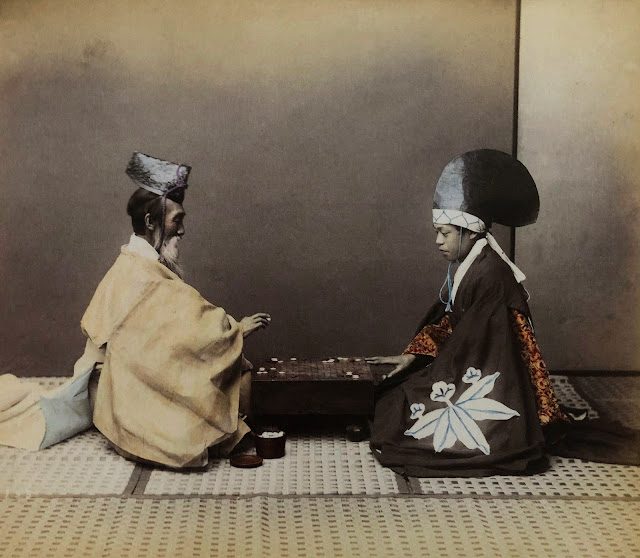TURKMENISTAN
Туркменскые Народные Песни / Turkmenian Folk Songs and Melodies – Melodiya 017901-2 (LP)
I’m delighted to present the fascinating musical tradition of the bakshy bards from Turkmenistan, a large, sparsely populated desert country on the Caspian Sea bordered by Kazakhstan, Uzbekistan, Afghanistan and Iran.
These professional traveling Turkmen bards perform at weddings and other social events by playing the long-necked dutar two-stringed lutes and gidjak spike fiddles and singing epics stories (dastan or destan) and oral folk literature. Bakshys are also historically associated with shamanism, magic and healing.
An apprentice performer undergoes rigorous formal traditional training under the tutelage of a halypa teacher in order to fully master the instruments and chants, as well as memorize historic dastan epics, before being ritually accepted into the community as a bakshy. Today, women can also become bakshys.
This LP, on the great Soviet label Melodiya, showcases this traditional art form at the heart of Turkmen culture and identity. We hear dutar lutes, gidjak fiddles and vocals, including dastan epics (A1, B1), folk songs (A4, B4) and dutar solo instrumentals (A3, B3).
The intense vocals here are characterized by their strange and stunning effects: “Perhaps the most distinctive trait of the bagshy repertoire is the abundance of non-musical, acoustic effects. These sounds are thought to be associated with magical spells. There are three different types: shouts or cries; ‘hiccups’ or ‘barks’ called juk-juk; and rustling sounds (snoring, moaning, murmuring).”*
J'ai le plaisir de vous présenter la fascinante tradition musicale des bardes bakshy du Turkménistan, un grand pays désertique peu peuplé situé au bord de la mer Caspienne et bordé par le Kazakhstan, l'Ouzbékistan, l'Afghanistan et l'Iran.
Ces bardes turkmènes professionnels itinérants se produisent lors de mariages et d'autres événements sociaux en jouant des luths à deux cordes dutar et des vièles gidjak, ainsi que des chants de récits épiques (dastan ou destan) et folkloriques. Les Bakshys sont également historiquement associés au chamanisme, à la magie et à la guérison.
Un apprenti suit une formation traditionnelle rigoureuse sous l’égide d'un professeur halypa afin de maîtriser les instruments et les chants, ainsi que de mémoriser les épopées dastan, avant d'être rituellement accepté dans la communauté en tant que bakshy. Aujourd'hui, les femmes peuvent également devenir des bakshys.
Cet album, paru sur le grand label soviétique Melodiya, présente cet art traditionnel au cœur de la culture et de l'identité turkmènes. On y entend des luths dutar, des vièles gidjak et des voix, avec notamment des épopées dastan (A1, B1), des chansons folkloriques (A4, B4) et des solos instrumentaux de dutar (A3, B3).
Les voix intenses se caractérisent ici par leurs effets étranges et étonnants : " Le trait le plus distinctif du répertoire bagshy est sans doute l'abondance d'effets acoustiques non musicaux. Ces sonorités sont associées à des sortilèges. Il en existe trois types différents : les cris ou les pleurs, les "hoquets" ou "aboiements" appelés juk-juk, et les bruissements (ronflements, gémissements, murmures) "*.
*https://theculturetrip.com/asia/turkmenistan/articles/the-bards-of-turkmenistan
A1 – Dushdi Nazarym (My Eyes Have Seen) – from Dastan “Seipel-Melek-Medkhal-Jemal”
Unknown Artist
A2 – Khal Iki Yandan (Your Birthmarks)
Ch. Tachmamedov (dutar) / A. Avliev (gidjak) and S. Japarov
A3 – Selbinyaz Kyrk – instrumental
D. Khansakhatov (dutar)
A4 – Amman-Amman (Spare Me) – lyrical folk song
M. Karliev
A5 – Kharaiym Dondi (Beloved Dondi)
O. Ilyasov & Folk Instruments Ensemble
B1 – Al Senem (Buy Me, Senem) – from the folk Dastan “Shahsenem and Garib”
Unknown Artist
B2 – Bileni (Ever With You)
M. Khalmamedov & Folk Instrument Trio
B3 – Gyrmyzy – instrumental
M. Tachmuradov (dutar)
B4 – Baga Baraly Gozel (Come to the Garden)
G. Chariev (singing and dutar) / Ja. Nurgeldiev (dutar) and G. Aliev (gijak)
B5 – Dil-Berim Yarashmaz (It Does Not Suit You)
G. Chariev (singing and dutar) / Ja. Nurgeldiev (dutar) and G. Aliev (gijak)
B6 – My Beauty
G. Chariev (singing and dutar) / Ja. Nurgeldiev (dutar) and G. Aliev (gijak)
Many thanks to our friend Julien for sharing this gem!
Photograph below is from Les Instruments de Musique Populaires by Alexandre Buchner, Gründ, 1969:
Turkmen musicians, Turkmenistan:
Please help me purchase important traditional records
to pursue my global curation project and share the
best finds with you on this blog:

%20-5%2071.jpg)
%2019%2039.jpg)
%200%2028.jpg)






%20-25%2078.jpg)
%20-5%2081.jpg)
%20-5%2082.jpg)
%20-5%2081.jpg)
%20-12%2045.jpg)
%20-4%2036.jpg)
%201-19%20100%20edit%20zither%20-14%2079.jpg)
%20-37%20100.jpg)
%20-21%20100%202.jpg)
%20-11%209.jpg)
%20-19%2011.jpg)

%20-23%2058.jpg)
%2021%2060.jpg)
%20-18%2061.jpg)
%20-11%2061.jpg)
